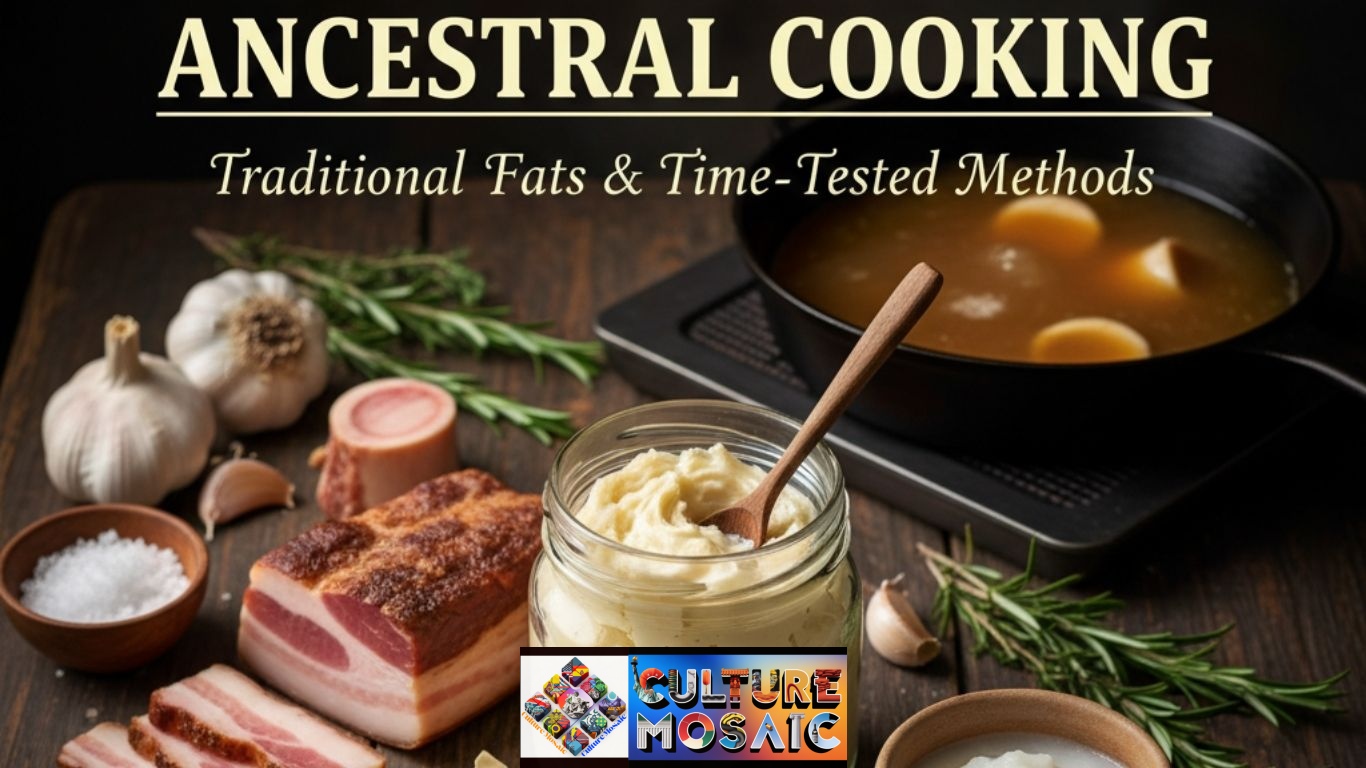Something interesting is happening in kitchens across America. Home cooks are tossing out their bottles of vegetable oil and reaching for beef tallow instead. Bakers are swapping regular butter for the cultured kind. And people who never thought twice about cooking fats are suddenly talking about smoke points and traditional rendering methods.
This isn’t just another food trend. Ancestral cooking represents a fundamental shift in how we think about preparing food. It’s about returning to the methods our great-grandparents used before the industrial food system changed everything.
What Is Ancestral Cooking?
Ancestral cooking refers to preparing food using traditional methods and ingredients that humans relied on for thousands of years. Think of it as cooking the way people did before factory processing, hydrogenated oils, and mass production took over.
The core principle is simple: use whole, minimally processed ingredients and cooking techniques that have stood the test of time. This means animal fats instead of seed oils, fermented foods instead of quick preservatives, and slow cooking methods instead of microwave shortcuts.
But ancestral cooking isn’t about living in the past. It’s about bringing forward the wisdom that worked and applying it to modern life. You’re not abandoning your kitchen appliances or hunting your own meat. You’re just making smarter choices about the fats, techniques, and ingredients you use.
The Ancestral Fat Revival: Tallow, Lard, and Cultured Butter
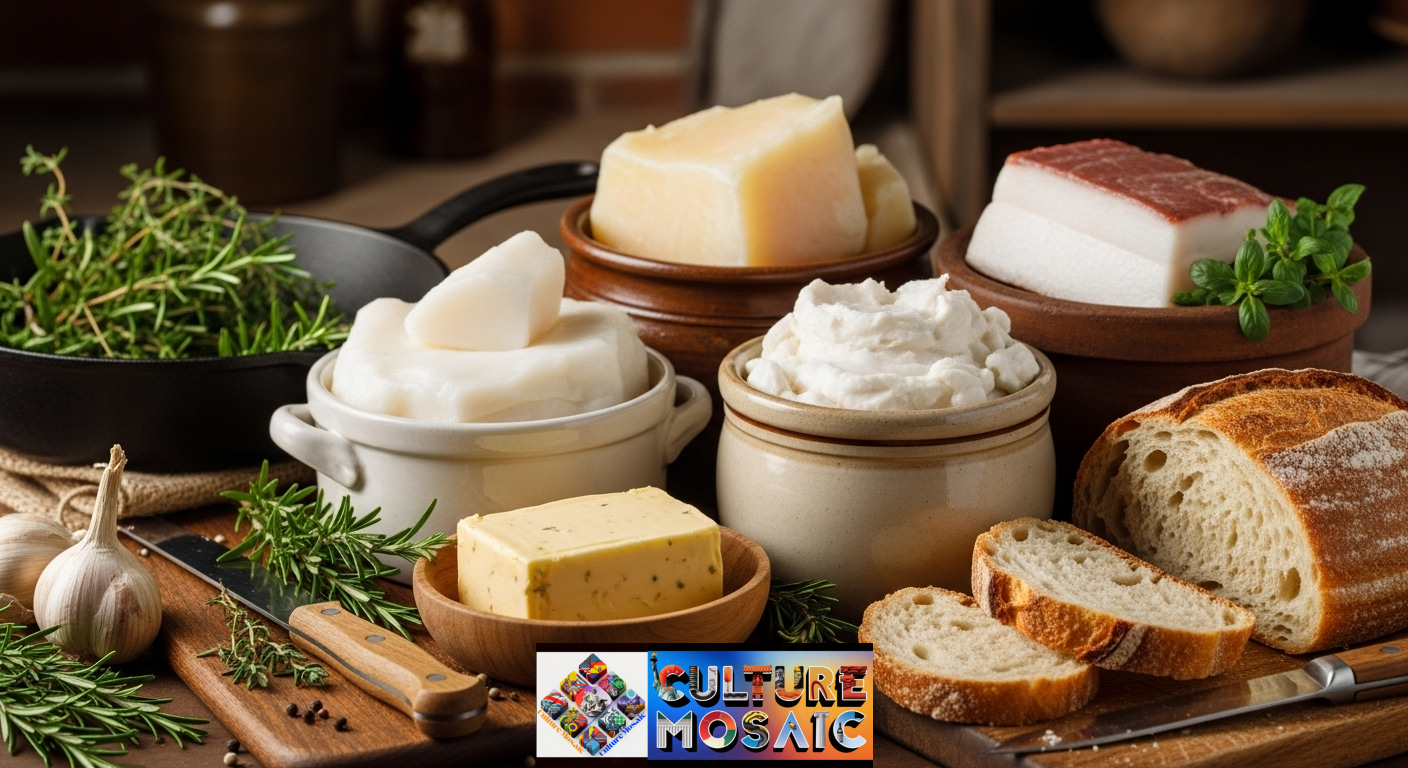
If you want to understand ancestral cooking, start with the fats. For most of human history, people cooked with animal fats. Beef tallow, pork lard, duck fat, and cultured butter were kitchen staples. Then came the mid-20th century, when food companies convinced everyone that vegetable oils were healthier.
Now the pendulum is swinging back.
Why Tallow Is Making a Comeback
Beef tallow is rendered fat from cattle. Your grandparents probably used it regularly. McDonald’s famously used it for French fries until 1990, which is why people still talk about how much better those fries used to taste.
Tallow has a high smoke point (around 400°F), making it perfect for high-heat cooking. It doesn’t break down or oxidize the way many seed oils do when heated. The flavor is rich and savory without being overwhelming.
More importantly, tallow fits perfectly into ancestral cooking philosophy. When you use tallow, you’re practicing nose-to-tail cooking. You’re using more of the animal instead of letting valuable parts go to waste.
The Cultured Butter Difference
Regular butter is made by churning cream. Cultured butter takes it one step further. The cream is fermented with live cultures before churning, creating a tangier, more complex flavor.
This was actually the original way butter was made. Before refrigeration, cream would naturally ferment slightly before people churned it. Modern cultured butter recreates this traditional process intentionally.
The fermentation creates beneficial compounds that may support gut health. It also makes the butter easier for some people to digest. And frankly, it just tastes better. Once you try cultured butter on warm sourdough bread, regular butter feels flat by comparison.
Why People Are Rejecting Seed Oils
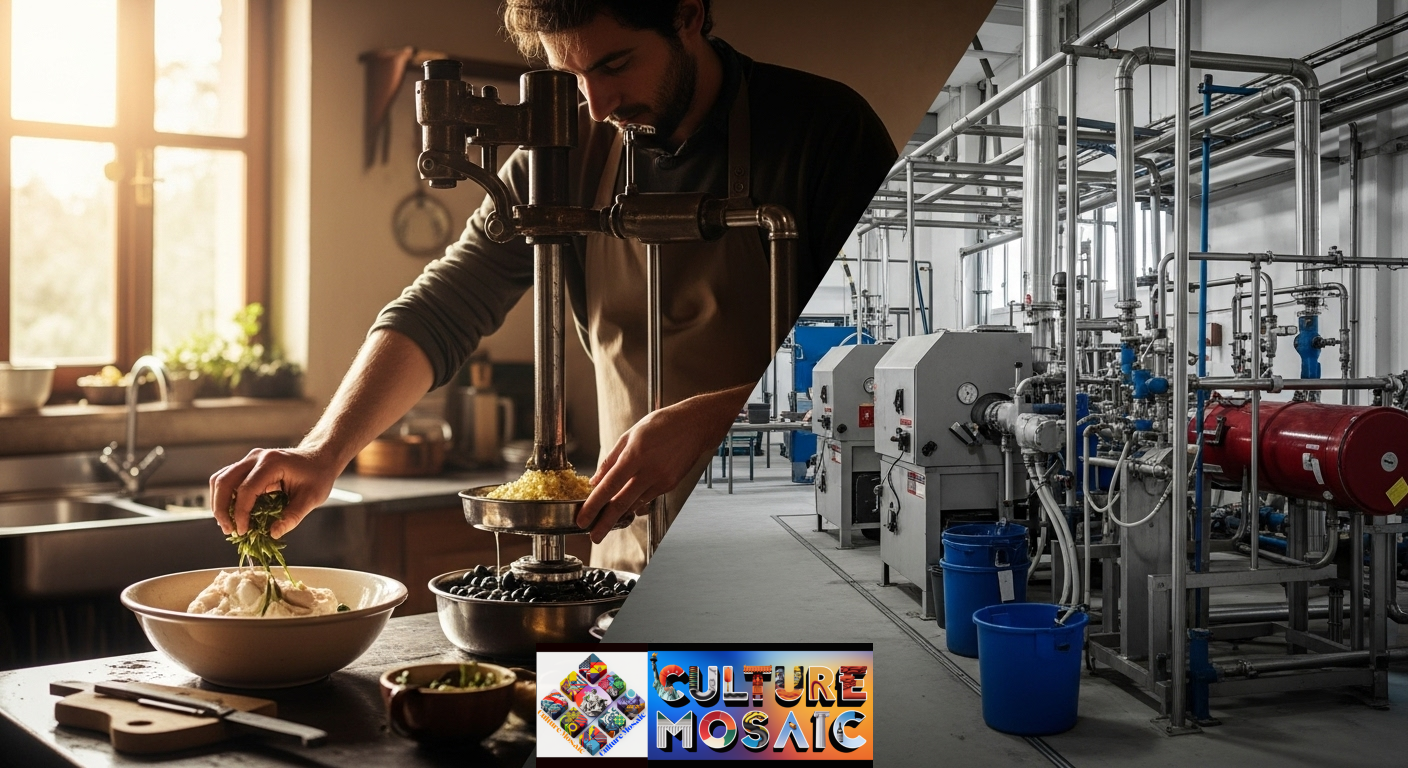
A big part of ancestral cooking is about what you don’t use. Most practitioners avoid industrial seed oils like canola, soybean, corn, and cottonseed oil.
These oils didn’t exist in the human diet until recently. They require heavy processing, high heat, and chemical solvents to extract. They’re high in omega-6 fatty acids, which most Americans already get too much of.
Ancestral cooking advocates argue that these oils weren’t part of traditional diets for good reason. Our ancestors used fats that occurred naturally and could be rendered or pressed without industrial equipment.
The ancestral cooking approach isn’t about demonizing any single ingredient. It’s about asking a simple question: would your great-grandmother recognize this as food?
How Ancestral Cooking Connects to Gut Health
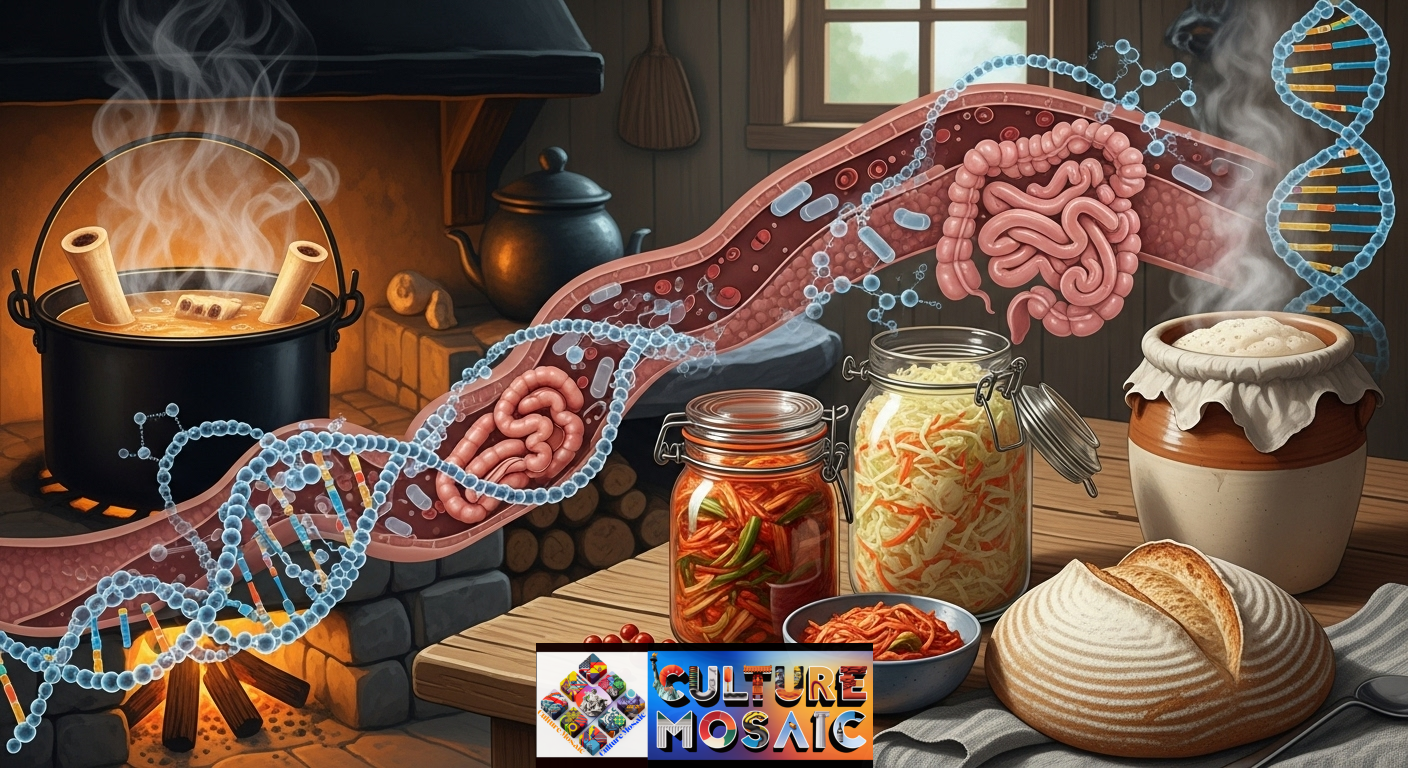
The gut health movement and ancestral cooking overlap significantly. Both emphasize fermented foods, traditional preparation methods, and skepticism toward processed ingredients.
Fermentation is a cornerstone of ancestral cooking. Before refrigeration, fermenting was one of the main ways to preserve food. Sauerkraut, kimchi, yogurt, kefir, and sourdough bread all come from this tradition.
These fermented foods contain beneficial bacteria that support digestive health. Cultured butter contains butyrate, a short-chain fatty acid that feeds the cells lining your gut.
Traditional bone broths, another ancestral cooking staple, provide gelatin and amino acids that some researchers believe support gut lining integrity. Slow-cooked tough cuts of meat become tender and more digestible.
The ancestral cooking perspective is that traditional methods naturally created foods that worked with human biology, because they evolved together over thousands of years.
Getting Started with Ancestral Cooking at Home
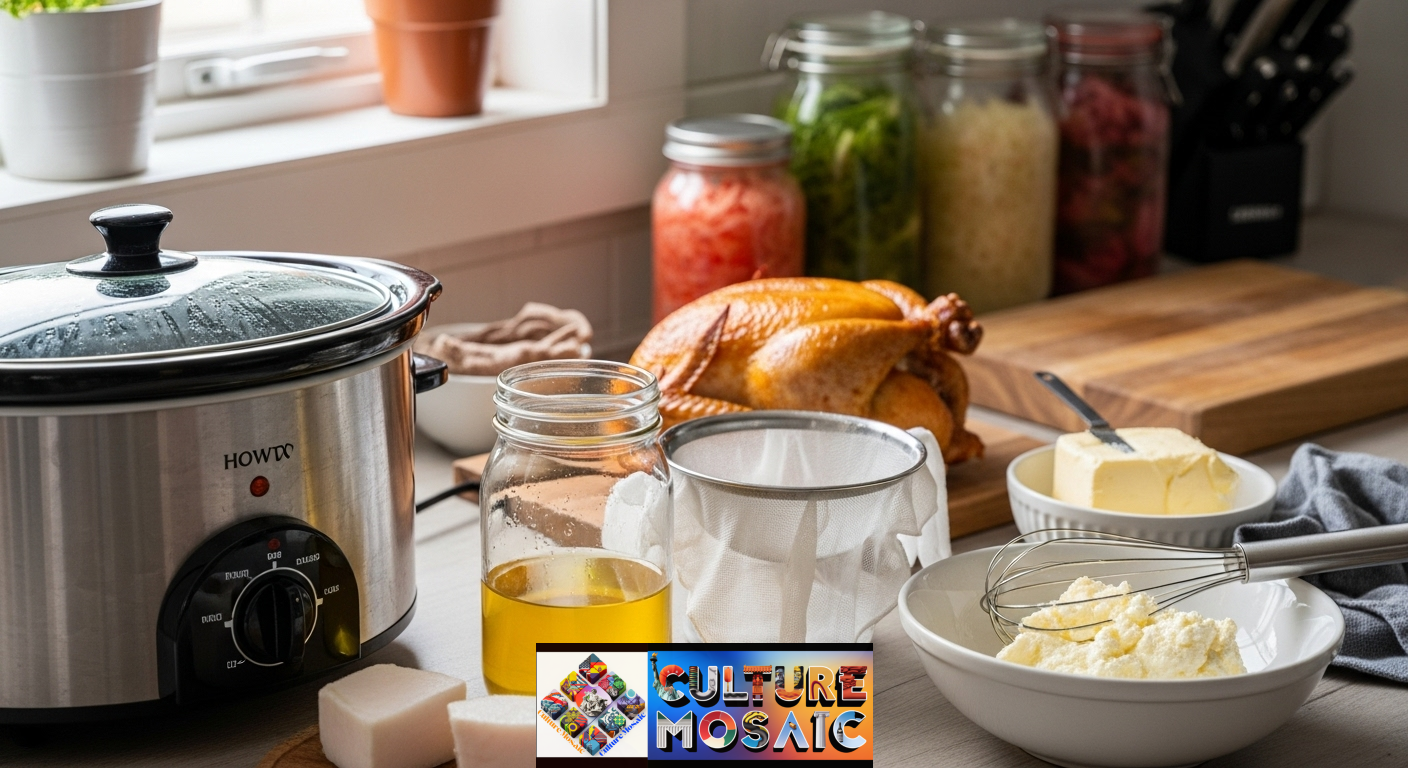
You don’t need to overhaul your entire kitchen overnight. Start with one or two simple swaps and build from there.
Rendering Your Own Tallow
Ask your local butcher for beef fat trimmings (called suet). Many butchers will give it to you for cheap or even free.
Cut the fat into small chunks and place them in a slow cooker or heavy pot on low heat. Let it cook for several hours until the fat has melted and the remaining bits turn crispy. Strain through cheesecloth into a glass jar.
Congratulations, you’ve just made tallow. Use it for roasting vegetables, frying potatoes, or searing steaks.
Finding or Making Cultured Butter
Many grocery stores now carry cultured butter in the dairy section. Look for brands like Vermont Creamery or Kerrygold (which isn’t always cultured but has a similar rich flavor from grass-fed cream).
To make your own, mix a couple of tablespoons of buttermilk or yogurt into heavy cream. Let it sit at room temperature overnight, then chill and churn in a food processor or stand mixer. Drain off the buttermilk, and you’re done.
Other Simple Swaps
Replace vegetable oil with tallow, lard, or coconut oil for high-heat cooking. Use butter or ghee for medium-heat cooking. Save olive oil for finishing dishes or salad dressings where it isn’t heated.
Buy a whole chicken instead of just breasts. Roast it, then use the bones to make broth. This is ancestral cooking in action.
Start a fermentation project. Make sauerkraut or pickle vegetables. You’ll need vegetables, salt, and a jar. That’s it.
The Flavor Argument for Ancestral Cooking
Here’s something that often gets overlooked in health debates: ancestral cooking methods simply produce better-tasting food.
Potatoes roasted in duck fat have a richness that olive oil can’t match. Vegetables sautéed in tallow develop a deep, savory quality. Pastries made with cultured butter have a complexity that makes store-bought versions taste one-dimensional.
Your great-grandparents didn’t use these fats just because they were available. They used them because they made food taste incredible.
Traditional cooking methods also tend to be more forgiving. Tough, inexpensive cuts of meat become tender and flavorful with slow cooking. Older vegetables work perfectly for fermentation. Leftover bones create rich stock instead of going to waste.
Common Misconceptions About Ancestral Cooking
Let’s clear up a few things. Ancestral cooking doesn’t mean eating only meat. Traditional diets around the world included plenty of vegetables, fruits, grains, and legumes. The key is how they were prepared.
It’s also not necessarily expensive. Yes, grass-fed tallow costs more than vegetable oil per ounce. But you often use less, and you can render your own from cheap fat trimmings. Cultured butter costs more upfront but goes further because of its intense flavor.
You don’t need special equipment. A heavy pot or slow cooker for rendering fat, mason jars for fermentation, and a basic food processor for making cultured butter will cover most techniques.
And no, ancestral cooking isn’t about giving up modern conveniences. Use your refrigerator, your oven, your food processor. The point is choosing ingredients and methods that align with traditional wisdom, not reenacting the past perfectly.
Regional Variations in Ancestral Cooking
Ancestral cooking looks different depending on where your ancestors lived. Mediterranean traditions emphasize olive oil, fish, and fermented vegetables. Northern European cooking relies heavily on cultured dairy and preserved fish. Asian ancestral cooking features fermented soy products, rice, and various animal fats.
This diversity is actually part of the philosophy. Real traditional diets varied based on what was locally available. The common thread is using whole, minimally processed ingredients prepared with time-tested techniques.
American ancestral cooking can draw from this global pantry. Use tallow from your local rancher, make kraut like German immigrants did, cook rice the way Asian traditions perfected it, and finish dishes with good olive oil.
Where to Source Quality Ingredients for Ancestral Cooking
Finding good ingredients matters. Look for grass-fed beef fat for rendering tallow. The fat from grass-fed animals has a better fatty acid profile and more nutrients.
Check farmers’ markets for pastured pork fat (for lard) and duck fat. Many small farms are happy to sell these items that bigger operations throw away.
For cultured butter, read labels. Real cultured butter will list “cultures” or “cultured cream” in the ingredients. Some expensive butters are just from grass-fed cows but aren’t actually cultured.
Online retailers now ship ancestral cooking staples. You can order grass-fed tallow, pasture-raised lard, and traditional ingredients that might not be available locally.
Building relationships with local butchers and farmers makes ancestral cooking easier and more affordable. Once they know you’ll buy fat trimmings and bones, they’ll often set them aside for you.
The Science Behind Traditional Cooking Fats
Research on dietary fats has shifted significantly in recent years. The idea that all saturated fat is bad has given way to a more complex understanding.
Tallow and lard are stable fats that don’t oxidize easily when heated, unlike many polyunsaturated oils. When oils oxidize, they form compounds that may contribute to inflammation.
The fatty acid profile of animal fats depends heavily on what the animal ate. Grass-fed beef tallow contains more omega-3 fatty acids and conjugated linoleic acid than grain-fed tallow.
Cultured butter’s fermentation creates vitamin K2, which plays a role in bone and heart health. It also contains butyrate, which feeds beneficial gut bacteria.
The point isn’t that ancestral cooking fats are magic. It’s that they’ve been part of human diets for thousands of years without the health problems that emerged after industrial food processing took over.
Combining Ancestral Cooking with Modern Nutrition Knowledge
The smartest approach combines ancestral wisdom with modern science. You don’t need to pick one over the other.
Use traditional fa, ts, but also eat plenty of vegetables. Make bone br, other but include plant-based foods rich in fiber and phytonutrients. Practice nose-to-tail cooking, but don’t ignore the value of plant foods.
Pay attention to quality. Ancestral people ate animals that lived on varied, natural diets. Factory-farmed animals eating corn and soy don’t provide the same nutritional profile.
Consider food sensitivities. Some people genuinely don’t tolerate dairy, even cultured versions. Others do better with certain fats than others. Ancestral cooking provides a framework, not a rigid prescription.
The goal is finding what works for your body while honoring traditional methods that sustained humans for millennia.
Making Ancestral Cooking Sustainable Long-Term
The best diet is one you’ll actually stick with. Ancestral cooking has advantages here because it emphasizes flavor and satisfaction, not deprivation.
Start small. Pick one new technique or ingredient per month. Master rendering tallow before moving on to making your own fermented vegetables.
Batch cook and prep. Render a large batch of tallow and it’ll last months in the fridge. Make several jars of kraut at once. Cook a big pot of bone broth and freeze it in portions.
Don’t stress about perfection. Eating fries cooked in tallow at a restaurant that sources it carefully is fine, even if you can’t always cook that way at home.
Connect with others interested in ancestral cooking. Online communities, local food groups, and farmers’ markets all offer chances to share tips and stay motivated.
The Cultural Renaissance of Ancestral Cooking
Something bigger is happening here. The ancestral cooking movement represents people reclaiming knowledge that was almost lost.
Food traditions that sustained families for generations nearly disappeared within a few decades of industrial food production. Now people are actively seeking out that wisdom from grandparents, old cookbooks, and traditional cultures.
This isn’t nostalgia. It’s recognition that maybe we gave up something valuable in the rush toward convenience. Maybe there were good reasons people cooked the way they did.
The ancestral cooking community includes everyone from serious health optimizers to home cooks who just want better-tasting food. What unites them is respect for traditional methods and skepticism toward ultra-processed products.
Moving Forward with Ancestral Cooking
You don’t need to commit to anything dramatic. Just try cooking some potatoes in tallow instead of vegetable oil. Buy a small container of cultured butter and taste the difference.
Notice how foods cooked in traditional fats taste richer and more satisfying. Observe whether you feel different eating foods prepared with these methods.
Ancestral cooking isn’t about following rules. It’s about reconnecting with food traditions that worked, making informed choices, and enjoying the process of preparing real food.
The goal is simple: cook in a way that nourishes your body, connects you to tradition, and produces food that tastes absolutely incredible.
Frequently Asked Questions About Ancestral Cooking
Q: Is ancestral cooking safe for people with high cholesterol?
A: The relationship between dietary fat and blood cholesterol is more complex than once thought. Many people find their lipid profiles actually improve when they switch from seed oils to traditional fats, though individual responses vary. If you have specific health concerns, work with a healthcare provider who understands ancestral nutrition to monitor your markers as you make changes.
Q: Where can I buy tallow and other traditional fats if I don’t want to render my own?
A: Many grocery stores now carry tallow and lard, often in the meat section or with the cooking oils. Look for grass-fed options from brands like Epic, Fatworks, or US Wellness Meats. Farmers’ markets, local butchers, and online retailers specializing in ancestral foods also stock these items. Cultured butter is increasingly common in regular supermarkets.
Q: Can I practice ancestral cooking if I’m on a budget?
A: Absolutely. Many ancestral cooking principles actually save money. Fat trimmings and bones are often cheap or free from butchers. Tougher cuts of meat cost less but become delicious with slow cooking. Fermenting vegetables extends their life and adds value. Making cultured butter costs less than buying it. Start with one or two changes and focus on what’s affordable in your area.
Q: How do I know if ancestral cooking is working for me?
A: Pay attention to how you feel. Many people report better energy levels, improved digestion, better satiety from meals, and fewer cravings for processed foods. Some notice better skin, better sleep, or easier weight management. Allow a minimum of one month before evaluating.
Changes in how you feel are often more telling than any specific metric.
Q: Do I need to give up all modern foods to do ancestral cooking properly?
A: Not at all. Ancestral cooking is a framework, not an all-or-nothing approach. Most people blend traditional methods with modern life. Use traditional fats for cooking, but keep your refrigerator. Make bone broth in a slow cooker. Buy cultured butter from the store instead of churning your own. The point is making better choices when you can, not achieving some perfect ideal of traditional eating.

